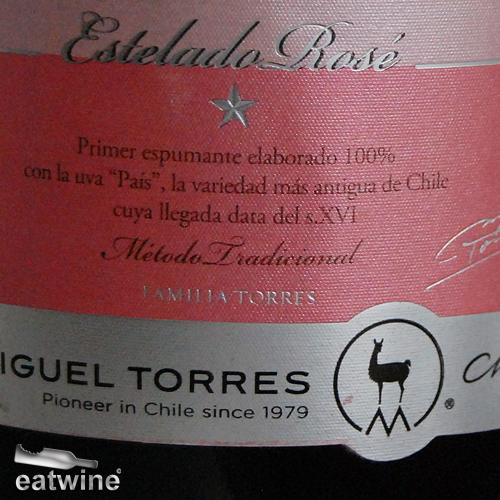 Never heard of the grape called país in Chile? You’re not alone. This grape goes back to the times of colonization in Chile by the Spanish. It’s not considered a fine wine that any self-respecting wine writer would evaluate (until now, hmm). It is a rustic wine used for the simple blends with Cabernet called burdeos in the countryside. Understanding this grape is entering a time machine to Chile’s past. There are still thousands of small producers in the southern wine valleys who tend to this grape—and now, an innovative new project breathing life into the wines made from it.
Never heard of the grape called país in Chile? You’re not alone. This grape goes back to the times of colonization in Chile by the Spanish. It’s not considered a fine wine that any self-respecting wine writer would evaluate (until now, hmm). It is a rustic wine used for the simple blends with Cabernet called burdeos in the countryside. Understanding this grape is entering a time machine to Chile’s past. There are still thousands of small producers in the southern wine valleys who tend to this grape—and now, an innovative new project breathing life into the wines made from it.
Meet Santa Digna Estelado. This collaborative project between the Spanish winery Miguel Torres and the University of Talca was partially financed by the Chilean government in an effort to resuscitate this grape variety and the agriculture surrounding its production. The results are impressive. This initiative began in 2007 when the Chilean government institution called FIA (Fundación para la Innovación Agraria) started to support the small grape farmers to improve the technology in the vineyard and cultivation of this grape. The objective? Produce a quality-driven, value-added product for a higher market niche beyond the traditional wine products like burdeos or chicha, a rustic grape cider.
To give you an idea of the significance, today in Chile there are over 37,000 acres of país grape vineyards planted in Chile, mostly in the southern valleys of Maule & Biobío (epicenter of the 2010 earthquake). Located in areas like San Javier and Cauquenes, this climatic zone is known as secano costero, a semi-arid coastal region. Growing most grapes here is difficult due to the scarcity of water and few vines have adapted to these dire conditions. Uva país however, remains victorious.
 To give you an idea in numbers, Miguel Torres cites that there are over 8,000 small grape farmers in this region who cultivate the país grape today. Thus, the initiative is to help them convert their vineyards with low profitability towards quality and a higher per ton price for the grapes. How to achieve this? Sparkling wines made with the champenoise method, one of Miguel Torres strengths in my opinion, as evidenced by their delicious Pinot Noir Brut which we have consumed as our house sparkler for many years. The low(er) alcohol percentage combined with the grapes’ natural high acidity makes the país grape a perfect candidate for zingy Chilean sparklers. Also consider that the domestic market for sparkling wine consumption in Chile is growing over 10% each year. This project (started in 2007) is timely.
To give you an idea in numbers, Miguel Torres cites that there are over 8,000 small grape farmers in this region who cultivate the país grape today. Thus, the initiative is to help them convert their vineyards with low profitability towards quality and a higher per ton price for the grapes. How to achieve this? Sparkling wines made with the champenoise method, one of Miguel Torres strengths in my opinion, as evidenced by their delicious Pinot Noir Brut which we have consumed as our house sparkler for many years. The low(er) alcohol percentage combined with the grapes’ natural high acidity makes the país grape a perfect candidate for zingy Chilean sparklers. Also consider that the domestic market for sparkling wine consumption in Chile is growing over 10% each year. This project (started in 2007) is timely.
While the focus of the project with Torres & FIA is to study the incremental gains for producers and how the public receives this type of high quality wine, I can tell you from tasting it upon release, it’s not only a well made wine, it’s vision and initiative is inspiring. In essence, the vision of Miguel Torres, a foreign winery in Chile, is bringing back a Chilean viticulture that has almost been forgotten. A wine culture that arrived over 500 years ago with the Spanish. Indigenous, if you will. Uniquely Chilean. The social impact of this project is noble as it supports small producers and fair trade (which the label in 2011 will reflect).
 So how does it taste? I LOVE this wine. It’s a rosé sparkler with a gorgeous pink hue. It has fresh, fruity notes and a mineral meets yeast component. In the mouth, it’s very dry (like Miguel Torres’ delicious Pinot Noir brut) and crisp. It has a wonderful, bright acidity that opens your palate for a meal or pairs perfectly with oysters, soft goat cheese, tapas. Best of all, the price is only around US$14 and you know that by purchasing and consuming this you’re supporting a movement. This is only the beginning. You’re saying yes to supporting the sustainable small producers of the país grape. You’re experiencing a uniquely Chilean initiative and terroir, all in a bottle of bubbly. Kuddos to Miguel Torres. I’ll be serving this at home for sure. It is exported to the US, Japan, and UK markets at this time. Check online to procure.
So how does it taste? I LOVE this wine. It’s a rosé sparkler with a gorgeous pink hue. It has fresh, fruity notes and a mineral meets yeast component. In the mouth, it’s very dry (like Miguel Torres’ delicious Pinot Noir brut) and crisp. It has a wonderful, bright acidity that opens your palate for a meal or pairs perfectly with oysters, soft goat cheese, tapas. Best of all, the price is only around US$14 and you know that by purchasing and consuming this you’re supporting a movement. This is only the beginning. You’re saying yes to supporting the sustainable small producers of the país grape. You’re experiencing a uniquely Chilean initiative and terroir, all in a bottle of bubbly. Kuddos to Miguel Torres. I’ll be serving this at home for sure. It is exported to the US, Japan, and UK markets at this time. Check online to procure.












